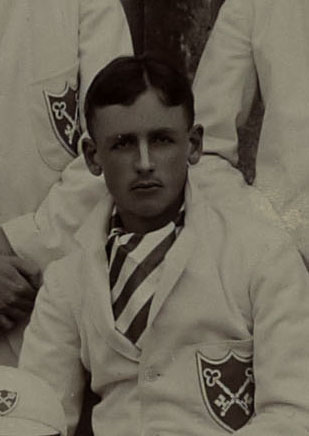
Hugh Bernard (Bobby) Morkill
Hugh was born on the 1st October 1896 at Austhorpe Lodge, Whitkirk, Leeds. His father, John William Morkill, had married Hannah Shaw Hobson in Edinburgh in 1889 and they would have 4 children, Hugh being the third youngest.
Hugh, like his father, was educated at Radley College Oxford enrolling there in 1910. He was a keen sportsman, being part of the College cricket XI in 1915 and a member of the first ever Rugby XV in 1914. During 1915 he was a college prefect. After college he enrolled at Sandhurst and was commissioned as a 2nd Lieutenant in December 1915. On the 22nd December 1915 he joined the Yorkshire Regiment.
In 1916 he was in India with the 1st Battalion. However, becoming restless with the relative inactivity he joined the Royal Flying Corps. He was sent to the 20th Training Wing in Egypt completing his ground course in September 1917. He then completed his flying training and qualified as a pilot on the 13th October 1917. Hopes of active service were dashed when he was retained as an instructor. However, the 19th September 1918 would see his first air action against Turkish positions in Palestine. Apparently a pet ring-tailed lemur called Jimmy often accompanied Hugh on his flights!
In 1922 he returned to the Yorkshire Regiment, eventually rising to the rank of Lieutenant-Colonel in 1940. He died in May 1991.
Mike Senior, who knew Hugh Morkill in his later years recently visited the museum and recounted this tale. “I remember the Colonel (by which title he was universally and affectionately known in the village) telling me the following story:
He claimed that his belief in God was confirmed because of a flying incident when in Palestine. He had been on a patrol and was returning to his base when thick cloud cut out all visibility. In those days aeroplanes were not technically advanced and the pilot had to rely on eyesight. The Colonel was lost and had no idea where he was. He flew around for some time and eventually the fuel gauge showed empty. He said a fervent prayer asking for God’s help. The engine began to splutter and he prepared for a crash landing. Then suddenly a gap appeared in the mist and immediately below him was his landing strip. He just managed to get the aeroplane, and himself, down safely.”
Explore more memories from the ribbon
-
Ernest Pigg
Ernest Pigg was the son of James and Maria Louise Pigg of 7 Langley Avenue, Thornaby on Tees. He enlisted in late 1914 and was posted to the 8th Battalion of the Yorkshire Regiment. The 8th Battalion left for France in late August 1915 and took over trenches in the area of La Rolanderie and Bois-Greniers. Having been in France for only one month 11605 Private Ernest Pigg is reported to have died of wounds on 28th September. He was buried at Sailly-sur-la-Lys Canadian Cemetery in the Pas-de-Calais. He was awarded the 1915 Star, the British War Medal and the Victory Medal. His effects, which were left to his father James, constituted £2-2s and a gratuity of £3-10s.
-
Fred Shaw
Fred, the fourth child of five to Ned and Ann Shaw, was born around 1884 at Slaithwaite near Huddersfield. His father Ned was a railway signal man and part time photographer. Two of Fred’s brothers would emigrate to Canada before the Great War began. Fred trained as a journeyman tailor and travelled to seek employment. Whilst in the Hawes district he met and married a girl from Hawes, Mary Elizabeth Blades, in November 1909. Fred enlisted in Hawes in June 1916, joining the 9th Battalion Yorkshire Regiment. Fred went to France in September 1916. Private Fred Shaw was killed on the first day of The Battle of Messines on the 7th June 1917 aged 33. Fred’s body was never found and his name is commemorated on the Menin Gate at Ypres. Sadly, just four and a half months after his father died, their son Jimmy died aged 5.
-
Harry Patch
When canvassing the local businesses for information about characters from the time of the First World War for our Ribbon of Remembrance, a major surprise came from Wendy, shop manager at the Castle Hill Bookshop. “You know what my name is?!” was her reply to the enquiry. Wendy Patch is the granddaughter of Harry Patch, the ‘Last Fighting Tommy’. Henry John Patch died on 25th July 2009, aged 111 years, having attained a level of celebrity that he can never have imagined at the time when he was No 2 on a Lewis gun team in the Duke of Cornwall’s Light Infantry. Harry was an apprentice plumber before he was conscripted into the army at the age of 18. He saw action at the Third Battle of Ypres, though his war came to an end on 22nd September 1917 following a German shell burst which killed three of his fellow Lewis gunners. Harry’s wound saw him hospitalised for 12 months. The Armistice came about while he was convalescing on the Isle of Wight. Following the war, Harry married Ada Billington, had two sons Denis and Roy and returned to work as a plumber. Harry only spoke about the war in the latter part of his life and when he did it was without any animosity towards the Germans who faced him across No-man’s Land. As one of the few Great War veterans who survived into the 21st century, Harry was invited to Buckingham Palace and 10 Downing Street. He was…
